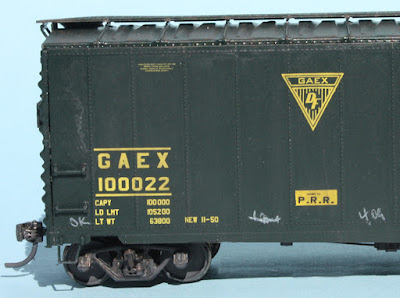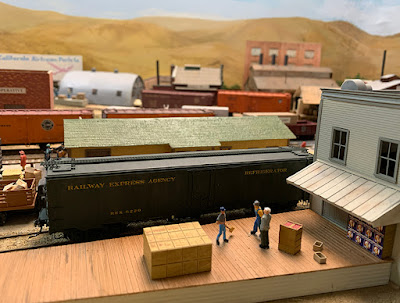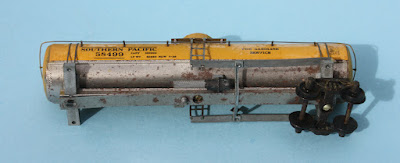I recently had an interesting question sent to me by email. The essence of the question was, “Is it realistic to operate three-compartment tank cars?” I did send the questioner a link to Richard Hendrickson’s article in Model Railroad Hobbyist on the topic (“Multiple-compartment tank cars” in Model Railroad Hobbyist, in the issue of February 2015). But it occurred to me that I could add some comments here.
Multiple-compartment tank cars of any kind were relatively rare; by one estimate about 95 percent of all tank cars in the transition era were single-compartment cars. Nevertheless, tank cars with two or more compartments did exist and were often photographed. In HO scale, the most familiar model of such a car is the old Athearn “Blue Box” three-compartment plastic model.
I show an example below. Note that the car has low-height expansion domes with single safety valves, correct for the car as shown, and has the double rivet rows between domes that represent the attachment of the internal bulkheads that separate the compartments. It even has three outlet pipes, one beneath each dome.
Problem is, no one has ever found a prototype three-compartment car this big, though this may well be what one would look like, if one existed. (Typical prototype three-compartment cars were usually much smaller, and had taller and narrower domes, by the way.)
This is an interesting model, with a discernible history. I have previously talked about the 1950s Athearn and Globe metal tank car kits (see that post at: https://modelingthesp.blogspot.com/2017/10/some-old-metal-tank-car-kits.html ), and it’s long been evident that when Athearn chose to create a new plastic tank car, they began with the three-compartment car shown above. Yet they once had a very nice metal tank car kit for a three-compartment car (shown in the post just cited).
As noted above, prototype three-compartment cars were considerably smaller than the Athearn model shown, often about 6000 gallons total capacity, half the volume of the model shown above. For background on real cars, I recommend John Riddell’s article in Mainline Modeler entitled “ACF Tank Car” (issue for September 1995, pages 42–47). Beyond that introduction, a much fuller account was is the Richard Hendrickson article published in Model Railroad Hobbyist, February 2015.
What occasioned Richard’s article was the release of the beautiful Tangent model of a 6000-gallon three-compartment tank car in HO scale. Here is Richard’s version of this model, lettered with Black Cat decals and with added placards, chalk marks, rust stains at tank bands, and spillage from the domes.
An even better model of a car like this was the Southern Car & Foundry resin kit, modeling a car built by Standard Tank Car Company (a model developed with Richard’s input on the prototype). Moreover, it models a car which later in life, had two new end compartments added, making three altogether (and the new domes are smaller, since they serve smaller compartments than the original single compartment). Here is one of these models built up, lettered to match a prototype photo.
As this SC&F model reminds us, many three-compartment cars came into being as modified single-compartment cars. I have accomplished the same for one of the common uses of such cars, wine transportation. (For much more about tank cars and the wine business, see my “Getting Real” column in the Model Railroad Hobbyist issue for May 2023.) Here is an example, shown spotted for loading at the winery in my layout town of Ballard:
This model began as a Proto2000 insulated tank car, and I added the two end domes, deliberately in a quite different style, consistent with many prototype wine cars. I described the modeling in that MRH article, and also in a prior blog post (see it at: http://modelingthesp.blogspot.com/2017/05/creating-wine-tank-car-part-2.html ).
My recommendation to modelers over the years has always been put those Athearn plastic three-dome cars in a storage box somewhere, to ensure no one sees them on your layout, and if you’re at all meticulous about freight cars, do the same with the Athearn plastic single-dome cars, with their hold-over low dome from the 3-dome model.
It’s a shame to have to say that, because the Athearn plastic single-dome car is a very accurate Southern Pacific 12,500-gallon tank car — except for that very obvious wrong dome, and a few lesser details. I have for years converted them, a full dozen cars by now, with dome correction and fixing all the other details. A pretty full description of how that is done is here: https://modelingthesp.blogspot.com/2011/05/modeling-sp-tank-cars.html .
But in summary, yes, three-compartment tank cars are entirely prototypical (if fairly rare), they just aren’t much like that old Athearn monster.
Tony Thompson

















































